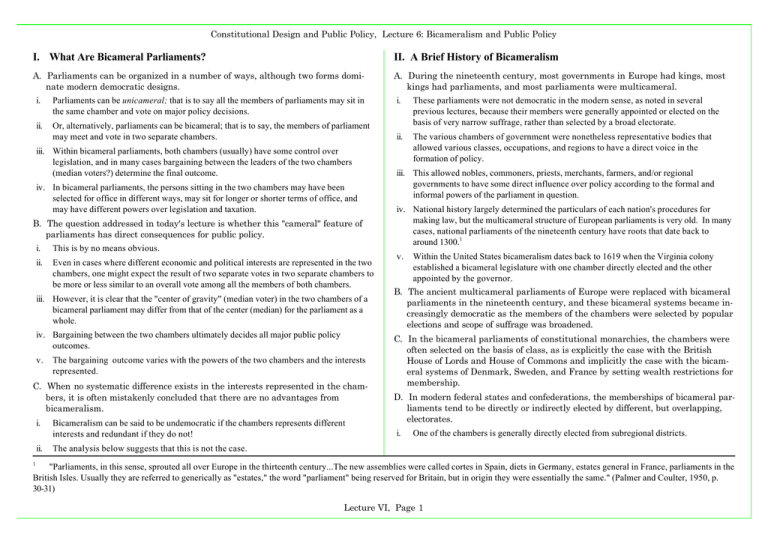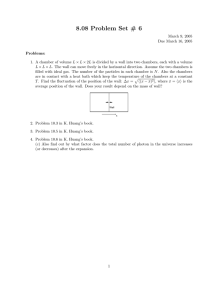I. What Are Bicameral Parliaments?
advertisement

Constitutional Design and Public Policy, Lecture 6: Bicameralism and Public Policy I. What Are Bicameral Parliaments? II. A Brief History of Bicameralism A. Parliaments can be organized in a number of ways, although two forms dominate modern democratic designs. A. During the nineteenth century, most governments in Europe had kings, most kings had parliaments, and most parliaments were multicameral. i. Parliaments can be unicameral; that is to say all the members of parliaments may sit in the same chamber and vote on major policy decisions. ii. Or, alternatively, parliaments can be bicameral; that is to say, the members of parliament may meet and vote in two separate chambers. iii. Within bicameral parliaments, both chambers (usually) have some control over legislation, and in many cases bargaining between the leaders of the two chambers (median voters?) determine the final outcome. iv. In bicameral parliaments, the persons sitting in the two chambers may have been selected for office in different ways, may sit for longer or shorter terms of office, and may have different powers over legislation and taxation. B. The question addressed in today's lecture is whether this "cameral" feature of parliaments has direct consequences for public policy. i. This is by no means obvious. ii. Even in cases where different economic and political interests are represented in the two chambers, one might expect the result of two separate votes in two separate chambers to be more or less similar to an overall vote among all the members of both chambers. iii. However, it is clear that the "center of gravity" (median voter) in the two chambers of a bicameral parliament may differ from that of the center (median) for the parliament as a whole. iv. Bargaining between the two chambers ultimately decides all major public policy outcomes. v. The bargaining outcome varies with the powers of the two chambers and the interests represented. C. When no systematic difference exists in the interests represented in the chambers, it is often mistakenly concluded that there are no advantages from bicameralism. i. ii. Bicameralism can be said to be undemocratic if the chambers represents different interests and redundant if they do not! i. These parliaments were not democratic in the modern sense, as noted in several previous lectures, because their members were generally appointed or elected on the basis of very narrow suffrage, rather than selected by a broad electorate. ii. The various chambers of government were nonetheless representative bodies that allowed various classes, occupations, and regions to have a direct voice in the formation of policy. iii. This allowed nobles, commoners, priests, merchants, farmers, and/or regional governments to have some direct influence over policy according to the formal and informal powers of the parliament in question. iv. National history largely determined the particulars of each nation's procedures for making law, but the multicameral structure of European parliaments is very old. In many cases, national parliaments of the nineteenth century have roots that date back to around 1300.1 v. Within the United States bicameralism dates back to 1619 when the Virginia colony established a bicameral legislature with one chamber directly elected and the other appointed by the governor. B. The ancient multicameral parliaments of Europe were replaced with bicameral parliaments in the nineteenth century, and these bicameral systems became increasingly democratic as the members of the chambers were selected by popular elections and scope of suffrage was broadened. C. In the bicameral parliaments of constitutional monarchies, the chambers were often selected on the basis of class, as is explicitly the case with the British House of Lords and House of Commons and implicitly the case with the bicameral systems of Denmark, Sweden, and France by setting wealth restrictions for membership. D. In modern federal states and confederations, the memberships of bicameral parliaments tend to be directly or indirectly elected by different, but overlapping, electorates. i. One of the chambers is generally directly elected from subregional districts. The analysis below suggests that this is not the case. 1 "Parliaments, in this sense, sprouted all over Europe in the thirteenth century...The new assemblies were called cortes in Spain, diets in Germany, estates general in France, parliaments in the British Isles. Usually they are referred to generically as "estates," the word "parliament" being reserved for Britain, but in origin they were essentially the same." (Palmer and Coulter, 1950, p. 30-31) Lecture VI, Page 1 Constitutional Design and Public Policy, Lecture 6: Bicameralism and Public Policy ii. The other chamber represents the interests of the constituent regional governments, as with the lander of Germany, provinces of the Netherlands, cantons of Switzerland, and states of the United States. E. The federal structure has proved more robust than the class-based systems in the modern democratic period. i. In countries where the membership of the chambers were grounded on representation of class interests, only a single chamber--the directly elected one--generally continues to have significant policymaking power in the year 2000. ii. For example, the United Kingdom (1915) and France (1958, A.45) revised policymaking rules so that their "upper" chambers could be overruled by their "lower" (directly elected) chambers.2 iii. Most bicameral systems where both chambers continue to have policymaking authority are associated with federal systems of governments. iv. The explicit representation of regional interests is more compatible with modern democratic norms than representation based on family history, wealth, or prestige. Regional governments are, or so it may be argued, closer to their electorates than are national governments and better able to represent their citizen's interests than are national governments, especially on regional concerns. F. This is not to say that bicameral systems based on federalism were unaffected by democratic tides; for example, the U. S. Senate and the Dutch first chamber have been elected rather than appointed for most of the past century. i. ii. Moreover, in some federal systems, the upper chambers represented regional and class interests at different times in their histories. Indeed, in some cases, class-based multicameralism was replaced by bicameral systems with an upper chamber representing class and regional government interests, followed by purely region-based bicameralism, and then elimination of bicameralism altogether. Denmark (1953) and Sweden (1970) explicitly ended their last bicameral legislatures through constitutional reforms that merged their regional and nonregional chambers. III. Is the EU Bicameral? A. The European Parliament and the Council of member states closely resembles the structure of modern federal democracies in which the "legislature" consists of a directly elected chamber and an indirectly elected federal council. i. The Consolidated Version of the Treaty Establishing the European Community describes the architecture of the government of the EU. Articles 189-191 state that the representative European Parliament "shall be elected by direct universal suffrage." ii. Articles 202-203 state that the Council "shall consist of a representative of each Member State at ministerial level, authorized to commit the government of that Member State." iii. The legislative procedures specified in the EU's present constitution are complex, but it is clear that in many, perhaps most, policy areas both the Council and the Parliament have to agree about the policies adopted, although the balance of power currently favors the Council over the Parliament.3 B. The commission can be regarded as the cabinet or "the government" for the present purposes. i. The Commission clearly has significant autonomy, after its appointment, as is also true of the cabinets of many parliamentary systems, but ultimately it remains controlled by the Council and the member states. ii. Its membership is selected jointly by the nations represented in the Council with consultation by the European Parliament (Article 214). iii. The Council can determine the size of the Commission (Article 213) and commission salaries (Article 210). C. The representation of European nations established in both the Council and the Parliament can be regarded as somewhat nondemocratic because some voter's interests are given greater weight than others. i. For example, Germany is arguably being underrepresented and Luxembourg substantially over represented.. 2 Tsebelis and Money (1997) argue that even upper chambers with no or little formal control over policymaking continue to influence the formation of public policy. Article 252 of the Consolidated Version of the Treaty Establishing the European Community states that: "Where reference in this Treaty to this Article for the adoption of an act, the following procedure shall apply: (a) The Council, acting by qualified majority on a proposal from the Commission and after obtaining the opinion of the European Parliament, shall adopt a common position. (b) The Council's common position shall be communicated to the European Parliament. The Council and the Commission shall inform the European Parliament fully of the reasons which lead the Council to adopt its common position and also of the Commission's position. ... (c) The European Parliament may within the period of three months by an absolute majority of its component Members, propose Amendments to the Council's common position. The European Parliament may also by the same majority reject the Council's common position. ...If the European Parliament has rejected the Council's common position, unanimity shall be required for the Council to act on a second reading." The commission may subsequently submit a revised proposal, which the council alone may consider. Amendments of this proposal by the Commission require unanimous agreement by the Council. (A. 252[e]). 3 Lecture VI, Page 2 Constitutional Design and Public Policy, Lecture 6: Bicameralism and Public Policy ii. This tends to be the case within all region-based forms of allocating representation insofar as the number of representatives (or votes by them) are constrained to be whole numbers. iii. (For example, it is clear that the unequal representation within the EU is not a consequence of bicameralism, but rather an effort to moderate political risks for "smaller" member states.) iv. The possible policy effects of this electoral inequality has attracted considerable research. (See, for example, Steunenberg, Schmidtchen, and Kolboldt 1999.) iv. For example, Hammond and Miller (1987), Brennan and Hamlin (1992), and Riker (1992) demonstrate that bicameralism helps avoid some problems with democratic cycles. v. Essentially, these articles point out that there are circumstances where a "median" or "pivotal" voter exists for each of two separate chambers, but where no median or pivotal voter would exist in the combined legislature. vi. In such cases, the pivotal voters of each chamber determine that chamber's policy and negotiation between the medians will yield an agreement that lies between the two medians. vii. The result is stable, because a majority in each chamber can be assembled for the proposals. IV. Analytical and Empirical Perspectives on Bicameralism A. There are essentially three strands to the modern theoretical literature on bicameralism. B. The first strand of the literature demonstrates that in some cases, bicameralism indirectly assures supermajority rule. D. A third strand of literature examines the effect of interchamber bargaining on legislative outcomes. i. It is clear that in bicameral systems where both chambers have veto power over the other that some form of compromise will be necessary. Shepsle and Weingast (1987) analyze how intercameral conference committees within the United States (where the legislative compromises are worked out) tend to empower legislative committees in both chambers. i. This line of research on bicameralism began with Tullock (1959) and with Buchanan and Tullock (1962, ch. 16). It suggests that bicameralism indirectly tends to increase the size of the majority that favors policies adopted. ii. ii. In “first-past-the-post” electoral systems, differences in electoral districts for the two chambers often imply differences in the representatives chosen. iii. Money and Tsebelis (1997) demonstrate that the power to delay implementation of a policy can also cause the bicameral systems to affect policy. iii. For example, spatially concentrated minorities tend to have greater representation in the "lower" chamber elected from smaller districts than in an "upper" chamber elected from relatively larger districts with more varied interests. iv. If both upper and lower chambers must agree for legislative proposals to become law, a broader cross-section of interests will have to be served in a bicameral legislature than in a unicameral legislature chosen either way. v. In this way, bicameralism can be defended as a method that tends to identify policies with supermajority support (Mueller 2000). C. A second strand of literature explores how bicameralism may generate democratic stability. i. It has been well-known since Duncan Black's work (1948a,b) that simple majority rule may fail to select a unique policy outcome. ii. How to avoid majoritarian indecisiveness has attracted a lot of attention in the academic literature since then. (As Arrow (1963) points out, indeterminacy--or intransitivity--is not simply a problem with majority rule, but with collective choice in general.) iii. Several authors have demonstrated that, in some circumstances, bicameralism can help stabilize majoritarian decision making. iv. M&T suggest that if there are different opportunity costs for the negotiation, as might be generated by a pending election, the decisive voter of the chamber prepared to wait the longest will secure a legislative outcome that is relatively close to "its" ideal point than that of the more impatient counterpart. v. Steunenberg, Schmidtchen, and Kolboldt (1999) and Steunenberg (2001) demonstrate how the more elaborate policymaking procedures of the present EU determine the relative power of the Commission, Council, and European Parliament, as well as the relative power of member states within the Union. E. Overall, these models predict that (1) bicameral systems are somewhat more stable than unicameral systems insofar as majority cycles are fewer, (2) levels of consensus required for legislation to be adopted tend to be somewhat higher than under unicameral systems insofar as the interests represented in the two chambers differ, (3) in cases where the chambers each have substantial influence, policy decisions tend to be more informed and faithful to the desires of the electorate, (4) the effect of bicameralism depends in part on the relative power of the two chambers, which is determined by the formal and informal procedures of negotiation between the chambers and the interests of the pivotal members of the two chambers. Lecture VI, Page 3 Constitutional Design and Public Policy, Lecture 6: Bicameralism and Public Policy V. Does Bicameralism Make Public Policy More Predictable? Table 1 Estimated Median Demand for Swedish and Danish Government Services A. Within a democracy, the predictability of government policy is jointly determined by the predictability of electoral demand and government policymaking in the face of that demand. i. In the usual rational choice models, voter policy preferences are not affected by the organizational structure of parliament. ii. Consequently, if government policy becomes less predictable after a bicameral system is transformed into a unicameral one, any new variation in government output of goods and services can be attributed to the shift from bicameralism to unicameralism. iii. If the demand for government services can be written as: Gt = v(Yt, It) + et , where Yt is the pivotal voter's income in period t and It is an index of his demand for government services, error term et will be conditioned on the existence of bicameralism. B. Both the Swedish and Danish experiences are consistent with that hypothesis, as illustrated in Table 1. VI. Conclusion A. Bicameralism can systematically affect public policy even when both chambers are elected in essentially the same way. In such cases, it may only affect the variance of public policy. (See my paper on Unbiased Bicameralism). C Real Priv. Con. (Per Capita) Voter Ideology ii. For example, in federal system a regional council may be designed to prevent policy decisions from being over centralized (as with the German, Swiss and American Systems.) i. This is particularly evident in cases where different parties control the two chambers of the parliament. ii. On the other hand, it can be argued that "divided government" may also produce problems insofar as responsibilities for public policies become difficult to attribute. Danish Gov. Con. (Per Capita) Gov. Con. (Log Per Cap.) Gov. Con. (Per Capita) Gov. Con. (Log Per Cap.) -3377.211 (-868)*** 0.701 (17.74)*** 7.329 (1.69)* -7.591 (10.23)*** -2015.02 (-3.47)*** 423.573 (2.37)*** 30.619 (15.55)*** 1.088 (0.70) 0.96 373.31** F-statistic 0.97 531.82*** 2.284 (32.28)*** 0.638 (1.56) 0.89 169.56*** 0.98 865.32*** Tests for Changes in Variance of Error Term Whites Het. Test Bicameral Residual S. 3.83** 93.66 2.96** 0.02 E. Unicameral Residual S. E. C. Bicameral systems tend to produce increased public debate, because differences between chambers tend to be more public (more covered in newspapers) than differences within a majority party tend to be. Real Danish 1.706 (19.65)*** 0.035 (1.22) R-squared Many of the "upper" chambers adopted in 19th century where designed to block anticipated whole scale redistribution by the more broadly elected "lower" chamber. iii. Bicameral systems that "over weight" the interests of some groups may do so intensionally as a way of reducing other sources of bias. Real Swedish Log Real Priv. Con/Pop Log Voter Ideology B. However, one may also attempt to use bicameralism to induce a bias--in order to counter biases associated with unicameral system. i. Real Swedish F-test for equivalence of variance 338.21 15.78*** 3.34** 45.76 0.125 248.75 29.55*** 0.17 1.84* 0.06 13.04 9.64 *** Denotes significance at the 0.01 level, ** denotes significance at the 0.05 level, and * denotes significance at the 0.1 level. Lecture VI, Page 4




